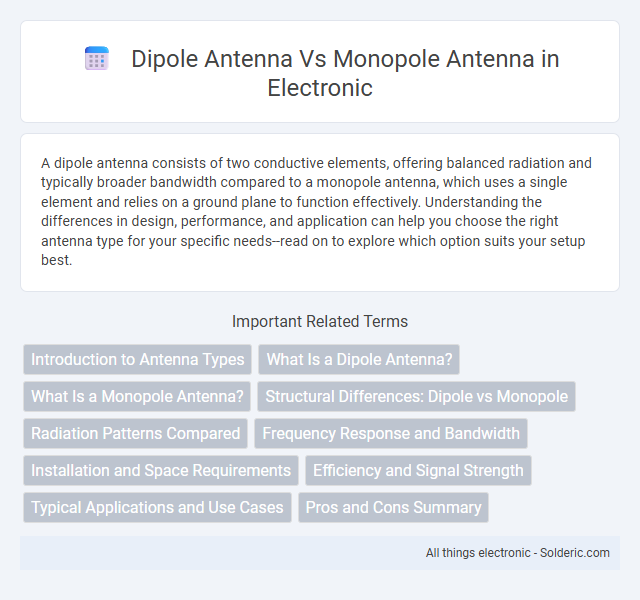A dipole antenna consists of two conductive elements, offering balanced radiation and typically broader bandwidth compared to a monopole antenna, which uses a single element and relies on a ground plane to function effectively. Understanding the differences in design, performance, and application can help you choose the right antenna type for your specific needs--read on to explore which option suits your setup best.
Comparison Table
| Feature | Dipole Antenna | Monopole Antenna |
|---|---|---|
| Structure | Two equal conductive elements | Single conductor above ground plane |
| Radiation Pattern | Bidirectional, figure-eight | Omnidirectional in horizontal plane |
| Length | Half-wavelength (l/2) | Quarter-wavelength (l/4) |
| Ground Plane | Not required | Essential for operation |
| Impedance | Approx. 73 ohms | Approx. 36.5 ohms |
| Applications | FM radio, television, HF and VHF communications | Mobile radios, vehicle antennas, base stations |
| Installation Complexity | Moderate | Simple |
Introduction to Antenna Types
Dipole antennas consist of two equal-length conductive elements oriented end-to-end, providing balanced radiation patterns ideal for broadband communication. Monopole antennas use a single conductive element positioned above a ground plane, creating an efficient design with a typically omnidirectional radiation pattern. The choice between dipole and monopole antennas depends on factors like installation environment, frequency band, and desired radiation characteristics.
What Is a Dipole Antenna?
A dipole antenna consists of two conductive elements, usually metal rods, oriented end-to-end and fed at the center with a balanced transmission line to create an effective radio signal radiator. This antenna type is known for its simple design and efficient radiation pattern, typically exhibiting a figure-eight shape in the horizontal plane. Understanding the characteristics of a dipole antenna can help you optimize your radio communication setup by providing better signal strength and coverage compared to a monopole antenna.
What Is a Monopole Antenna?
A monopole antenna consists of a single conductive element mounted perpendicularly over a conductive surface or ground plane, acting as a quarter-wavelength radiator. It operates by reflecting radio waves off the ground plane, effectively creating an image element that forms the other half of a dipole, resulting in efficient radiation patterns. Your choice of a monopole antenna suits applications needing compact design and omnidirectional coverage, especially in mobile and broadcast communication systems.
Structural Differences: Dipole vs Monopole
Dipole antennas consist of two conductive elements typically arranged symmetrically around a central feed point, each element acting as a radiator, whereas monopole antennas use a single conductive element mounted perpendicularly above a conductive ground plane, relying on the ground to act as a mirror image of the missing half. The dipole's balanced structure leads to a center-fed design with symmetrical current distribution, while the monopole's unbalanced structure results in a ground-dependent radiation pattern. Your choice between dipole and monopole antennas depends on available space, installation complexity, and desired radiation characteristics influenced by these fundamental structural differences.
Radiation Patterns Compared
Dipole antennas exhibit a bidirectional radiation pattern with maximum signal strength perpendicular to the antenna axis, ideal for broadside coverage. Monopole antennas present an omnidirectional radiation pattern in the horizontal plane, providing consistent signal strength around the antenna but limited vertical coverage. Understanding these radiation patterns helps you choose the right antenna for applications requiring either directional focus or uniform coverage.
Frequency Response and Bandwidth
Dipole antennas typically offer a broader frequency response and wider bandwidth compared to monopole antennas due to their symmetrical structure and balanced feed, enabling efficient signal transmission over multiple frequency ranges. Monopole antennas, while simpler and more compact, generally exhibit narrower bandwidth and more limited frequency response, often requiring tuning or loading techniques for multi-band performance. Understanding these differences helps optimize Your antenna choice for applications demanding specific broadband or narrowband frequency characteristics.
Installation and Space Requirements
Dipole antennas require a balanced installation with two conductive elements, often needing more horizontal space and support structures, making them ideal for open areas. Monopole antennas use a single vertical element and rely on a ground plane, allowing installation in smaller spaces with simpler mounting on rooftops or masts. Understanding your available installation area helps optimize antenna performance and ensures effective signal transmission.
Efficiency and Signal Strength
Dipole antennas generally exhibit higher efficiency and stronger signal strength due to their balanced design, which reduces ground losses and radiation pattern distortion. Monopole antennas rely on a ground plane, which can introduce inefficiencies and signal attenuation if not properly implemented. Optimizing ground plane size and placement significantly impacts monopole antenna performance, but dipoles typically outperform monopoles in consistent signal quality and overall radiation efficiency.
Typical Applications and Use Cases
Dipole antennas are commonly used in television and radio broadcasting, amateur radio, and wireless communication systems due to their balanced radiation pattern and ease of installation. Monopole antennas are often employed in mobile devices, vehicle communication systems, and base stations for cellular networks, benefiting from their compact size and compatibility with ground planes. Both antenna types serve critical roles in RF signal transmission, with dipoles favored for directional applications and monopoles suited for omnidirectional coverage.
Pros and Cons Summary
Dipole antennas offer balanced radiation patterns and are easier to model for predictable performance, but require a ground plane and can be bulkier than monopole antennas. Monopole antennas are typically smaller, simpler, and use a single conductor above a ground plane, providing omnidirectional coverage, though their performance heavily depends on the quality of the ground plane and they may exhibit higher feedpoint impedance. The choice between dipole and monopole antennas depends on application-specific factors like size constraints, installation environment, and desired radiation characteristics.
dipole antenna vs monopole antenna Infographic

 solderic.com
solderic.com